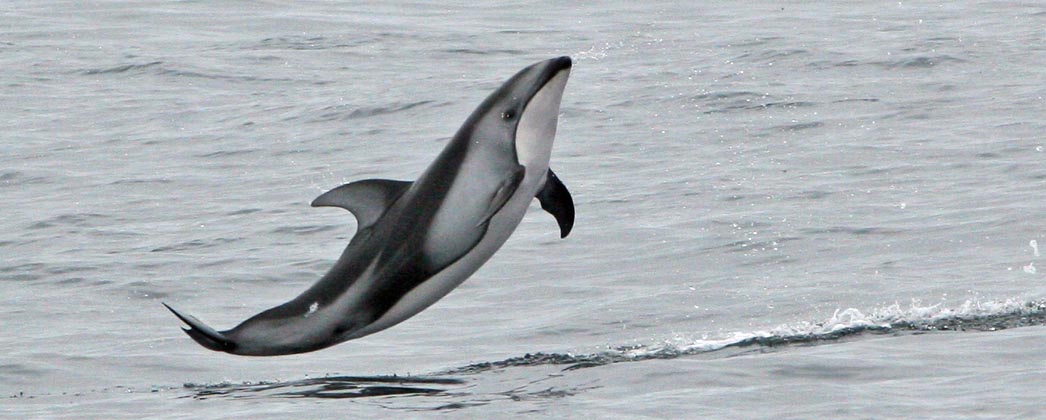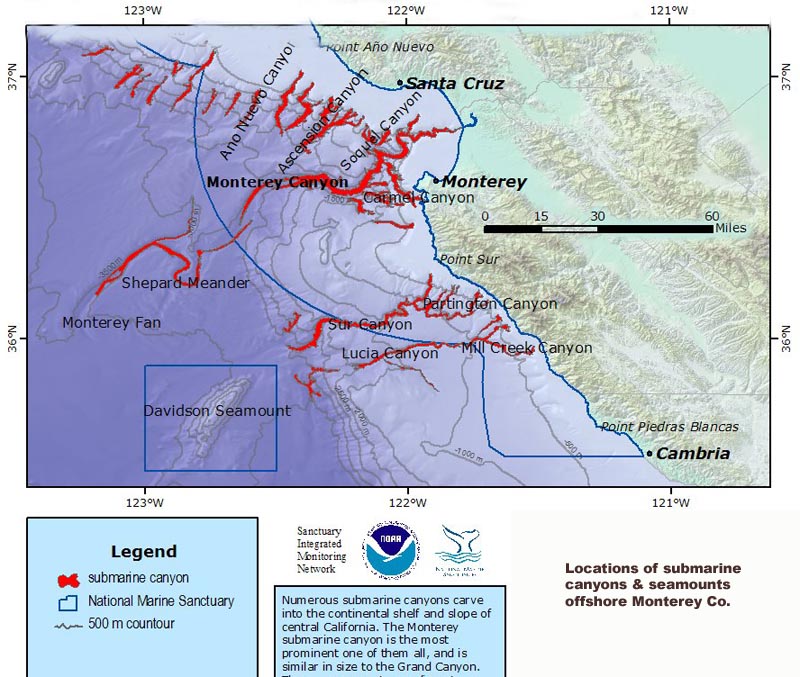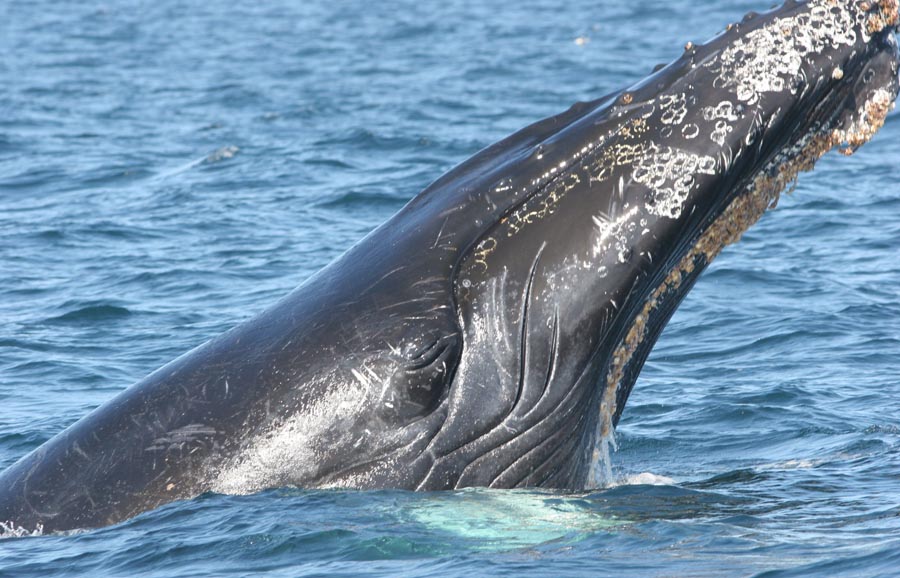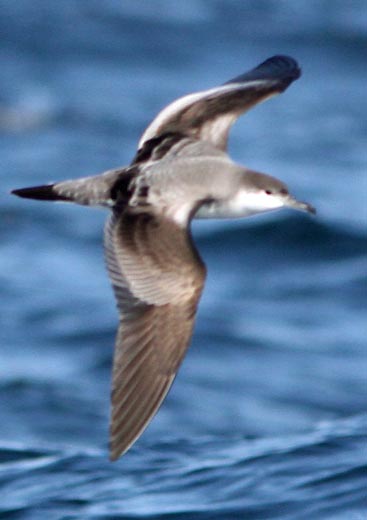a page by Don Roberson |
 |
||||
 |
||||
A boat trip on Monterey Bay is certainly a major highlight of any visit to Monterey County. What is seen depends on the season, weather, sea-surface temperature and salinity, winds, currents, and patchiness of food. Some days are spectacular; others can be cold, foggy, and slow-going. But there are always birds, and each trip is different. Check out a bar graph from eBird — showing ever-changing results of checklists submitted to 5 eBird hot spots in the Monterey Bay area and within Monterey County — for a fair representation of what to expect. |
||||
 |
||||
Unless aboard a NOAA or other research ship, it takes 24 hours to run a fishing boat to the Davidson Seamount and back to Monterey harbor. Birders have operated such trips occasionally, but the vast majority of pelagic trips are within Monterey Bay. Some longer trips are advertised for the "Monterey Seavalley" or the "albacore grounds," and these head west of the Monterey Peninsula and beyond the continental shelf to deeper waters 20-40 nmi offshore. Monterey pelagic trips are offered from time to time by Audubon Societies or other charters, but two companies offer regular pelagic birding trips each fall, and occasionally other seasons: Each trip is led by experienced sea-birders. In addition, whale-watching trips are available almost every day of the year from Fisherman's Wharf, Monterey. There are several companies, but Monterey Bay Whalewatch trips often have skippers that know seabirds (tell the leader you are interested in birds). |
||||
These days, with a lot of interest in county birds by California observers, most pelagic trips pay attention to "county lines" offshore. There are two types of boundaries offshore. First, there are the formal county lines that extend 3 miles out from the shore, or from a 'closed bay,' that are laws of the State of California. These are detailed in California's Government Code. Since Monterey Bay is legally a "closed bay," its boundaries are set by law and are shown by the red lines on the map below. Beyond these statutory lines, there are imaginary lines that divide up the 200 nautical miles of offshore waters that are within the United States' exclusive economic zone. Within this 200 nmi offshore area, any bird encountered is assigned to the county that is the nearest point of land from that offshore bird (islands included). In the map below, the yellow line shows the boundaries between Santa Cruz Co. (SCZ) and Monterey Co. (MTY) within the exlusvie economic zone (EEZ). For a much more detailed discussion of this topic, see by web page on county boundaries offshore. |
||||
 |
||||
|
||||
| A unique feature of some trips in September-October is the opportunity to see the storm-petrel flocks that gather then on Monterey Bay. Where the flocks occur changes year to year, or from one decade to another. Recently they have been along the north rim of the submarine canyon. On a calm day, and with a careful skipper, a boat may approach closely. A significant percentage of the world's population of Ashy Storm-Petrel may be here (up to 10,000 birds), and in 'warm water' years good numbers of Black Storm-Petrel will be present (both species are apparent in the second photo below; the Blacks are mostly to the far right). Among these flocks we search for the few Fork-tailed, Wilson's, Least, or Leach's that may be present (there is a record of Wedge-rumped Storm-Petrel in 1977). | ||||
 |
||||
 |
||||
At the other end of the size spectrum are albatrosses. Black-footed Albatross (just below) can be encountered year-round, but peak numbers are in the spring and summer. Laysan Albatross is
much rarer (second shot below), and used to be mostly limited to winter
trips, but more recently has been found in any month as its range
expands. The rarest of our three north Pacific species is Short-tailed Albatross
(sometimes called "Steller's Albatross;" 3d photo down). It almost went
extinct in World War II but the population is slowly recovering. We are
seeing it more frequently on Monterey Bay again. It would surely be the
highlight of any pelagic trip. |
||||
 |
||||
 |
||||
 |
||||
|
||||
 |
||||
The Monterey Harbor is a great spot to bird even if you are not headed out to sea on a pelagic trip. See a separate page: |
|
page created 11-19 Aug 2012 |
all
photos & text © Don Roberson |
back to HOME |
 There
is nothing quite like leaving the Monterey harbor early aboard a small
fishing boat to search for pelagic birds on Monterey Bay. Someone gets
chum going out the back and gulls begin to follow, as they will all
day. The eager gulls encourage shearwaters and albatrosses to come to
the boat to seek food. Although at sea, the boat will be traversing
over some of the most dramatic underwater topography on earth, as a
huge submarine canyon — as big as the Grand Canyon — lies beneath the
surface. Its steep walls create an upwelling of deep-sea nutrients
towards the surface, encouraging a productive growth of krill, the
basis of a food-web from tiny squids to huge whales.
There
is nothing quite like leaving the Monterey harbor early aboard a small
fishing boat to search for pelagic birds on Monterey Bay. Someone gets
chum going out the back and gulls begin to follow, as they will all
day. The eager gulls encourage shearwaters and albatrosses to come to
the boat to seek food. Although at sea, the boat will be traversing
over some of the most dramatic underwater topography on earth, as a
huge submarine canyon — as big as the Grand Canyon — lies beneath the
surface. Its steep walls create an upwelling of deep-sea nutrients
towards the surface, encouraging a productive growth of krill, the
basis of a food-web from tiny squids to huge whales.  The
general offshore topography appears on this map (right) from the
Monterey Bay Marine Sanctuary, showing its boundaries (blue lines) and
the submarine canyons (in red). Also note the Davidson Seamount, which
lines underwater ~60 miles SW of Pt. Sur.
The
general offshore topography appears on this map (right) from the
Monterey Bay Marine Sanctuary, showing its boundaries (blue lines) and
the submarine canyons (in red). Also note the Davidson Seamount, which
lines underwater ~60 miles SW of Pt. Sur. 

